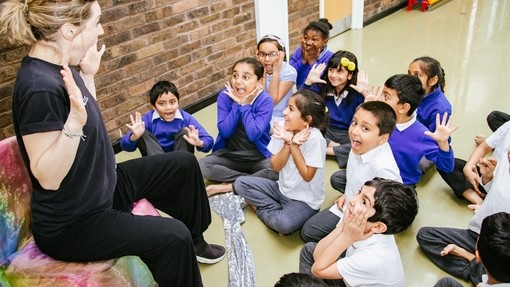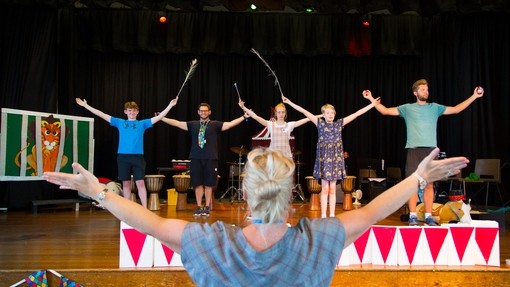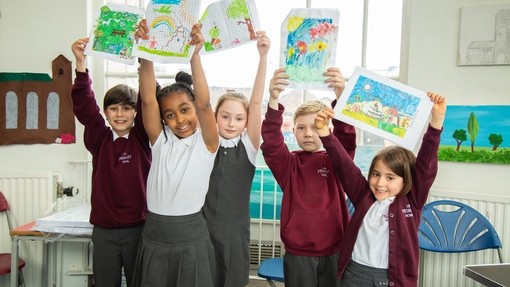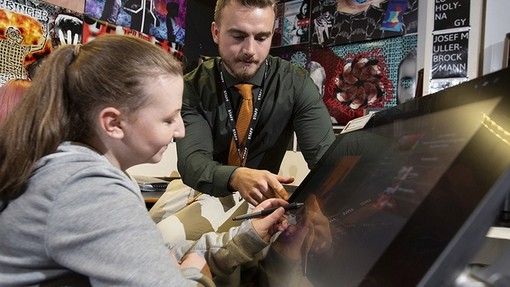
Jayne Seddon is an artist, educator, creative producer, and Artsmark Partner. Her practice sits at the intersection of Art, Climate Action, and excellence in Arts Education. As Artist in Residence at LIPA Primary and High School, she works collaboratively with the school and a range of cultural partners to develop innovative art projects for both the LIPA pupils and the other settings they support.
Over the last six years, her role has evolved with the school driven by a shared vision and commitment to creating a culture of creativity in teaching and learning. Jayne is supporting LIPA on their first Artsmark journey and shares her top tips for arts leaders.
1. Help children to identify as artists
“I am a superb artist and I like myself” says Enzo in Year 3. This is music to my ears. Working with children provides an endless source of creative energy, and that spark is so engaging. Although I am teaching the children fine art skills, I work collaboratively with them. I tell them all the time; we are artists exploring the world around us together. For children to work with me and to see me around their school each week helps them to identify as artists and to understand the world through the values of critically engaged thinking. This supports resilience, emotional literacy, the development of a visual language, and increased confidence.
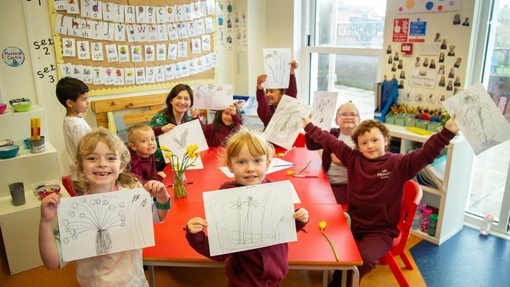
2. Build partnerships
“If Art Leaders have access to a range of professional artists, they can enhance enrichment offers for children. This makes projects more exciting and engaging, building confidence, success, and aspiration.” says Rebecca Oakes, Y1 Teacher and Maths and Artsmark Lead.
A great place to start is by getting in touch with your Artsmark Bridge organisation. In the north west we have Curious Minds. Dr Steph Hawkes, Senior Manager of External Funding & Policy at Curious Minds worked with LIPA to access Heritage Lottery funding for Revolutionary Nature - our early years programme connecting children to the natural world around them. They’ll also point you in the direction of your local Artsmark Partners. These could be art galleries, museums, theatres, or creative practitioners.
3. Start to develop drawing skills in early years
In April each year, the reception classes at LIPA work on Revolutionary Nature. The concept is simple: connecting children with the natural world, through creative experiential learning, and enhancing their drawing skills.
A wildflower meadow is being created in The Liverpool Oratory grounds next to the Anglican Cathedral. The LIPA pupils are drawing the garden and its growth as it’s being created, teaching them about the cyclical stages of natural systems.
Encouraging children to identify as artists during their early years is embedded throughout this project. They develop their visual language faster - like handwriting, each child has a distinct way of mark making which becomes evident at this stage in their development. The development of fine motor skills at school is more intuitive when a child experiences joy, curiosity, and a love for learning.
4. Practice is key
Children should practice creative activity every day. Just ten minutes a day can have an impact, so be inventive in how you try to embed creativity throughout the school day. “I love how we sing up and down the corridors!” says Katie in Year 4. Our Year 4 teacher and music lead ensures that all children sing in class daily. An Art Week once a year is not enough, according to Professor of Surgery at Imperial College London, Roger Kneebone. Faculty members at the university have noticed a marked decline in the manual dexterity of students and evidence suggests fewer ‘hands-on’ courses in schools is a contributing factor.
5. Ask your children to advocate
Ask your children to lead. Our children wanted extra-curricular art, so we set up after-school Eco Arts. This time is the highlight of the week for many of our children. It’s a valuable time for friendships and wellbeing as well.
At LIPA, we have an active School Council that make decisions on the development of their school. They sit on staff interviews panels. Our Arts Council children are our creative ambassadors. They have developed advanced art and music skills and confidently deliver workshops and perform both in school and during public events for Liverpool Light Night. We have an in-house music team who offer an afterschool choir and a range of instrumental music lessons to every child. These are free for our 29% of children who access Pupil Premium.
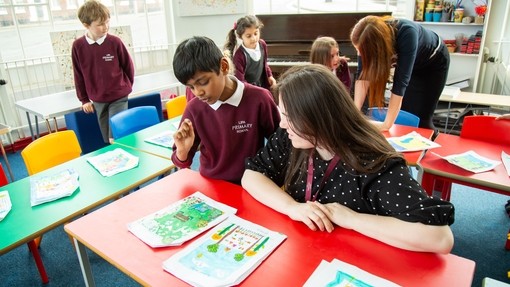
6. Empower Children to share their artwork
Children must connect with art venues, not just as a passive audience or well-behaved observers, but as participants and creators. Not all children will experience great culture outside of school, so, as educators, it’s our responsibility to connect them with awe inspiring art. Find an Artsmark Partner or artist, build your pupils’ cultural capital and get the children’s work out there in the public realm!
Why Artsmark?
“Artsmark is the next stage on our journey to excellence in the creative and performing arts” says Greg Parker, LIPA’s headteacher. Artsmark is not just an award in our view, it’s a process which in practice will support how you embed creativity through your curriculum. Our Action Plan helps us to ensure we are using this time to make meaningful steps such as:
- Embedding the Arts Councils Seven Quality Principles through our curriculum
- Investing in Continued Professional Development for teachers -a simple 30-minute workshop can enhance staff confidence, performance, and wellbeing
- Improving our school grounds - co-design of the school garden with our Eco Council Children
- Ensuring our children know the value of arts - why should it be audacious for children from all backgrounds to aspire to work in the creative industries?
- Sharing best practice - we want to be even more strategic about where we go next and think about how we can support other schools and education settings with their arts provision
Art is a human right for every child
Recognise the power of art to transform and transcend challenges. Art isn’t just for the privileged few. All children, with all of their complexities, should have access to excellence in arts. LIPA Primary School has received national recognition for its inclusive approach to education by being made a flagship school by Inclusion Quality Mark (IQM).
Holly Lucas, our Deputy Head, and Inclusion Lead, says “To ensure all the children with all of their different needs can take part in all activities and feel properly included takes a lot of work, but we do this because we all just want the best for them.”
LIPA Primary ensured that art projects were delivered to all children both in school and at home throughout lockdowns. We delivered a whole school project, The Colours of LIPA, an art and wellbeing project based upon colour association, and connecting with the school community.
We draw upon the vibrant culture of the city and the wealth of creative expertise in our school community. The Founder of LIPA and Artsmark Governors Mark Featherstone-Witty explains: “The purpose of compulsory schooling is to help youngers discover what they love doing and are good at so, the creative arts must be there. Aside from this, the creative and performing arts reach unique parts of the human psyche and so are a human right.”
For children, making art is fundamental to self-expression and creating space to explore their aspirations.
“Art relaxes me and creates a peaceful environment in my head.” We couldn’t agree more with Leah who’s in Year 6.

